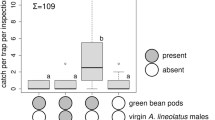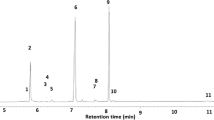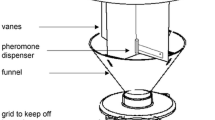Abstract
Extracts of different body parts of adult Trichoptera were tested for electrophysiological activity. Extracts of the IVth and Vth abdominal sternites of femaleHydropsyche angustipennis, Rhyacophila nubila, andR. fasciata, containing a paired exocrine gland, elicited significant electroan-tennographic responses when tested on conspecific male antennae. The paired gland occurs also in males of all the species, and inH. angustipennis, extracts from males were more active than female extracts when tested on male antennae. Female and male extracts from all species were analyzed by gas chromatography with simultaneous flame ionization and electroantennographic detection (EAD). EAD-active peaks in female extracts, stimulating male antennae, were identified inH. angustipennis as nonan-2-one; and inR. nubila andR. fasciata as heptan-2-one, heptan-2-ol, nonan-2-one, and nonan-2-ol. EAD-active components from maleH. angustipennis stimulating male antennae were octan-2-one, nonan-2-one (major peak), (Z)-6-nonen-2-one, decan-2-one, and a methylbranched decan-2-one. Female extracts and synthetic mixtures of compounds identified from femaleH. angustipennis andR. fasciata were tested for attractivity in the field. High catches with control traps obscured the results, but a synthetic mixture of the four identified compounds was significantly attractive and not different from female extracts for attracting maleR. fasciata. InH. angustipennis, a synthetic six-component male blend, in which nonan-2-one was the major component, attracted significant numbers of male and femaleH. angustipennis. Extracts of maleR. nubila andR. fasciata contained acetophenone and hexanoic and octanoic acids but did not have any electrophysiological or behavioral activity on either male or female antennae of conspecifics. The occurrence of a female sex pheromone inRhyacophila and an aggregation pheromone inHydropsyche corresponds to earlier described differences in mating behaviors in the Rhyacophilidae and Hydropsychidae.
Similar content being viewed by others
References
Anderbrant, O., Löfqvist, J., Jönsson, J., andMarling, E. 1989. Effects of pheromone trap type, position and colour on the catch of the pine sawflyNeodiprion sertifer (Geoff.) Hym., Diprionidae).J. Appl. Entomol. 107:365–369.
Ansteeg, O., andDettner, K. 1991. Chemistry and possible biological significance of secretions from a gland discharging at the 5th abdominal sternite of adult caddisflies (Trichoptera).Entomol. Gen. 156:303–312.
Arn, H., Tóth, H., andPriesner, E. 1992. List of Sex Pheromones of Lepidoptera and Related Attractants, 2nd ed. International Organisation for Biological Control, Montfavet, France.
Becker, G. 1987. Lebenszyklus, Reproduktion und ökophysiologische Anpassungen vonHydropsyche contubernalis, einer Köcherfliege mit Massenvorkommen in Rhein. PhD thesis. University of Köln, Germany.
Benz, G. 1975. Über die Tanzschwarme der KöcherfliegeHydropsyche pelluciduala Curtis (Trichoptera: Hydropsychidae).Mitt. Schweiz. Entomol. Ges. 48:147–157.
Birch, M.C., andHaynes, K.F. 1982. Insect Pheromones (Studies of Biology No. 147). Edward Arnold Limited, London.
Cardé, R.T., andBaker, T.C. 1984. Sexual communication with pheromones, pp. 355–383,in W.J. Bell and R.T. Cardé (eds.). Chemical Ecology of Insects. Chapman and Hall, London.
Cummings, B.F. 1914. Scent organs in Trichoptera.Proc. Zool. Soc. London 2:459–474.
Duffield, R.M. 1981. 2-Nonanol in the exocrine secretion of the nearctic caddisfly,Rhyacophila fuscula (Walker) (Rhyacophilidae: Trichoptera).Proc. Entomol. Soc. Wash. 83:60–63.
Duffield, R.M., Blum, M.S., Wallace, J.B., Lloyd, H.A., andRegnier, F.E. 1977. Chemistry of the defensive secretion of the caddisflyPycnopsyche scabripennis (Trichoptera: Limnephillidae).J. Chem. Ecol. 3:649–656.
Esben-Petersen, P. 1916. Vaarfluer. Danmarks Fauna, Vol. 19. G.E.C. Gads forlag, Copenhagen.
Fligner, M.A., andPolicello, G.E. 1981. Robust rank procedures for the Behrens-Fisher problem.J. Am. Stat. Assoc. 76:162–168.
Gruhl, K. 1960. Die Tanzgesellschaft derHydropsyche saxonica McLach. (Trichoptera).Mitt. Disc. Entomol. Ges. 19:76–83.
Kelner-Pillault, S. 1975. Attirance sexuelle chez une Trichoptère:Enoicylla pusilla (Burmeister).Bull. Soc. Entomol. Fr. 80:252–257.
Löfstedt, C. 1991. Evolution of moth pheromones, pp. 57–73,in I. Hrdy (ed.). Proceedings of the 3rd International Symposium on Trichoptera. Series Entomologica, vol. 20. Tabor 1990. Academia Prague and SPB Acad. Publ., The Hague.
Mosely, M.E. 1923. Scent-organs in the genusHydroptila (Trichoptera).Trans. R. Entomol. Soc. London 1923:291–294.
Moretti, G.P., andBicchierai, M.C. 1981. Comparative SEM and TEM studies on the andocrinal structures ofLasicocephala basalis Kol. and other Trichoptera, pp. 193–198,in G.P. Moretti (ed.). Proceedings, 3rd International Symposium Trichoptera, Ser. Entomol. Vol. 20, Dr. W. Junk publishers. The Hague.
Nielsen, A. 1980. A comparative study of the genital segments and the genital chamber in female Trichoptera.K. Dan. Vidensk. Selsk. Biol. Sk. 23:1–199.
Percy-Cunningham, J.E., andMacDonald, J.A. 1987. Biology and ultrastructure of sex pheromone-producing glands, pp. 27–76,in G.D. Prestwich and G.J. Blomquist (eds.). Pheromones Biochemistry. Academic Press, London.
Resh, V.H., andWood, J.R. 1985. Site of sex pheromone production in three species of Trichoptera.Aquat. Insects 7:65–71.
Roelofs, W.L. 1976. The scope and limitations of the electroantennogram technique in identifying pheromone components, pp. 147–164,in McFarlane (ed.). Crop Protection Agents. Academic Press, New York.
Ross, H.H. 1967. The evolution and past dispersal of the Trichoptera.Annu. Rev. Entomol. 12:169–205.
Schumacher, H. 1969. Das Schwarmverhalten vonHydropsyche borealis Martynov (Insect Trichoptera).Zool. Anz., suppl., Bd. Verh. Zool. Ges. 33:555–558.
Solem, J.O. 1985. Female sex pheromones inRhyacophila nubila (Zettersetedt) (Trichoptera: Rhyacophilidae) and arrival pattern to sticky traps.Fauna Norv. Ser. B 32:80–82.
Struble, D.L., andArn, H. 1984. Combined gas chromatography and electroantennogram recording of insect olfactory responses, pp. 161–178,in H.E. Hummel and T.A. Miller (eds.). Techniques in Pheromone Research. Springer-Verlag, New York.
Sullivan, R.T. 1981. Insect swarming and mating.Fla. Entomol. 64:44–65.
Tobias, W. 1972a. Zur Kenntnis europäischer Hydropsychidae. I.Senckenbergiana Biol. 53:59–89.
Tobias, W. 1972b. Zur Kenntnis europäischer Hydropsychidae. II.Senckenbergiana Biol. 53:245–268.
Wood, J.R., andResh, V.H. 1984. Demonstration of sex pheromones in caddisflies (Trichoptera).J. Chem. Ecol. 10:171–176.
Author information
Authors and Affiliations
Rights and permissions
About this article
Cite this article
Löfstedt, C., Hansson, B.S., Petersson, E. et al. Pheromonal secretions from glands on the 5th abdominal sternite of hydropsychid and rhyacophilid caddisflies (Trichoptera). J Chem Ecol 20, 153–170 (1994). https://doi.org/10.1007/BF02065998
Received:
Accepted:
Issue Date:
DOI: https://doi.org/10.1007/BF02065998




